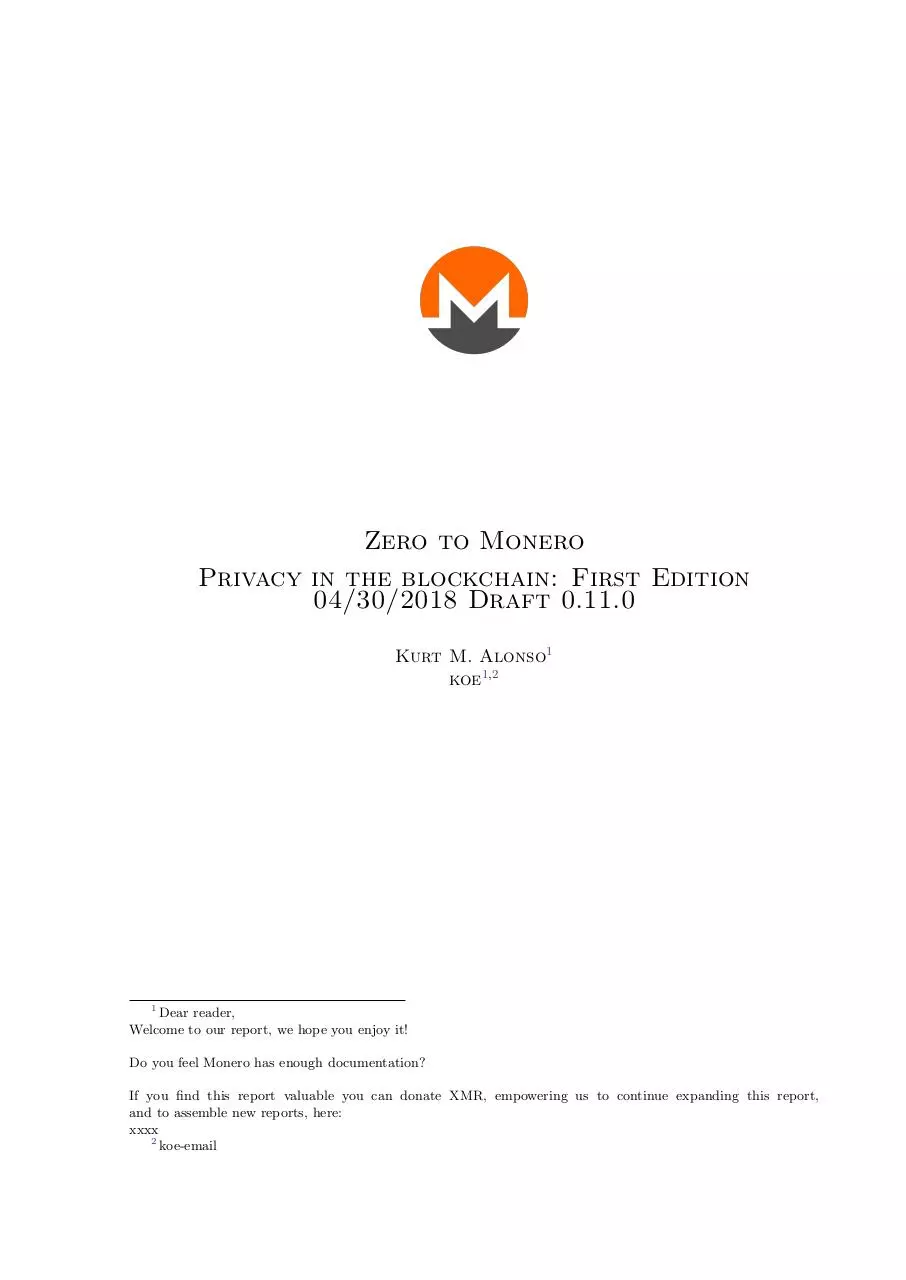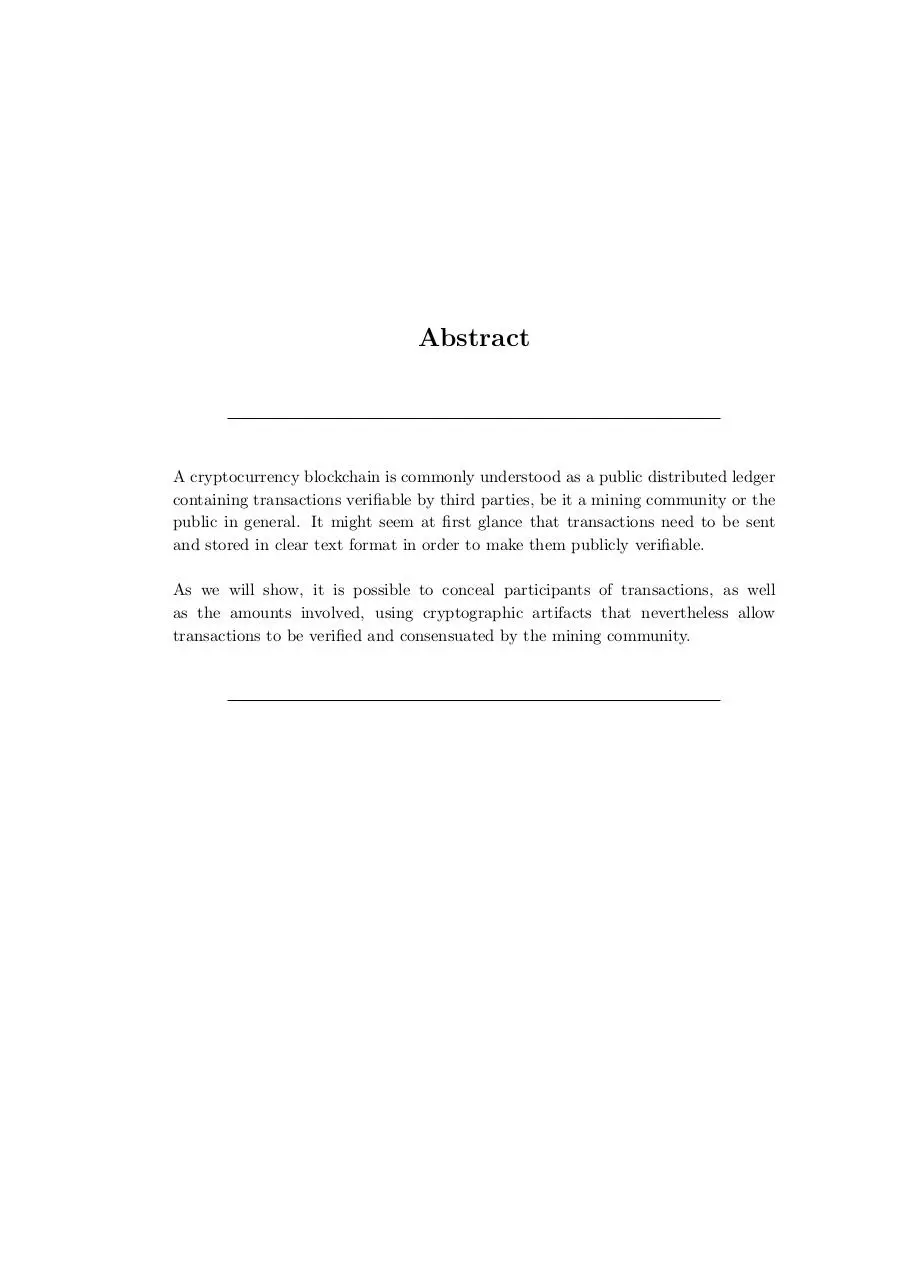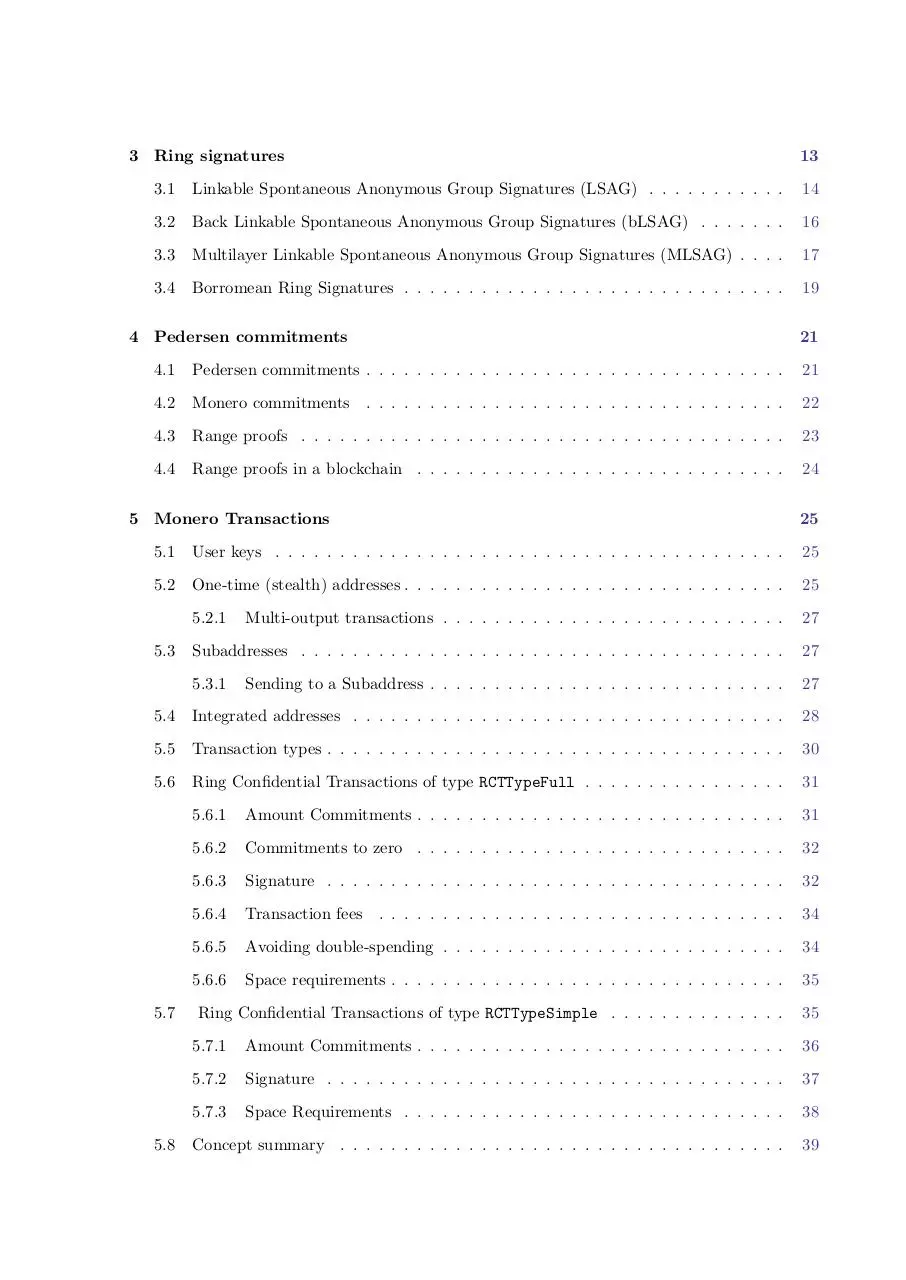Zero to Monero First Edition v0 11 1 (PDF)
File information
Title: Zero to Monero - First Edition
Author: Kurt and koe
This PDF 1.5 document has been generated by LaTeX with hyperref package / pdfTeX-1.40.18, and has been sent on pdf-archive.com on 01/05/2018 at 22:31, from IP address 75.168.x.x.
The current document download page has been viewed 592 times.
File size: 530.36 KB (55 pages).
Privacy: public file





File preview
Zero to Monero
Privacy in the blockchain: First Edition
04/30/2018 Draft 0.11.0
Kurt M. Alonso1
koe1,2
1
Dear reader,
Welcome to our report, we hope you enjoy it!
Do you feel Monero has enough documentation?
If you find this report valuable you can donate XMR, empowering us to continue expanding this report,
and to assemble new reports, here:
xxxx
2
koe-email
Abstract
A cryptocurrency blockchain is commonly understood as a public distributed ledger
containing transactions verifiable by third parties, be it a mining community or the
public in general. It might seem at first glance that transactions need to be sent
and stored in clear text format in order to make them publicly verifiable.
As we will show, it is possible to conceal participants of transactions, as well
as the amounts involved, using cryptographic artifacts that nevertheless allow
transactions to be verified and consensuated by the mining community.
Contents
1 Introduction
1
1.1
Objectives . . . . . . . . . . . . . . . . . . . . . . . . . . . . . . . . . . . . . . . .
2
1.2
Readership . . . . . . . . . . . . . . . . . . . . . . . . . . . . . . . . . . . . . . .
2
1.3
Origins of the Monero cryptocurrency . . . . . . . . . . . . . . . . . . . . . . . .
2
1.4
Outline . . . . . . . . . . . . . . . . . . . . . . . . . . . . . . . . . . . . . . . . .
3
2 Basic concepts
4
2.1
A few words about notation . . . . . . . . . . . . . . . . . . . . . . . . . . . . . .
4
2.2
Elliptic curve cryptography . . . . . . . . . . . . . . . . . . . . . . . . . . . . . .
5
2.2.1
What are elliptic curves . . . . . . . . . . . . . . . . . . . . . . . . . . . .
5
2.2.2
Public key cryptography with elliptic curves . . . . . . . . . . . . . . . . .
7
2.2.3
Diffie-Hellman key exchange with elliptic curves . . . . . . . . . . . . . . .
8
2.2.4
DSA signatures with elliptic curves (ECDSA) . . . . . . . . . . . . . . . .
8
Curve Ed25519 . . . . . . . . . . . . . . . . . . . . . . . . . . . . . . . . . . . . .
9
2.3
2.3.1
Binary representation . . . . . . . . . . . . . . . . . . . . . . . . . . . . .
10
2.3.2
Point compression . . . . . . . . . . . . . . . . . . . . . . . . . . . . . . .
10
2.3.3
EdDSA signature algorithm . . . . . . . . . . . . . . . . . . . . . . . . . .
11
iii
3 Ring signatures
13
3.1
Linkable Spontaneous Anonymous Group Signatures (LSAG) . . . . . . . . . . .
14
3.2
Back Linkable Spontaneous Anonymous Group Signatures (bLSAG) . . . . . . .
16
3.3
Multilayer Linkable Spontaneous Anonymous Group Signatures (MLSAG) . . . .
17
3.4
Borromean Ring Signatures . . . . . . . . . . . . . . . . . . . . . . . . . . . . . .
19
4 Pedersen commitments
21
4.1
Pedersen commitments . . . . . . . . . . . . . . . . . . . . . . . . . . . . . . . . .
21
4.2
Monero commitments . . . . . . . . . . . . . . . . . . . . . . . . . . . . . . . . .
22
4.3
Range proofs . . . . . . . . . . . . . . . . . . . . . . . . . . . . . . . . . . . . . .
23
4.4
Range proofs in a blockchain . . . . . . . . . . . . . . . . . . . . . . . . . . . . .
24
5 Monero Transactions
25
5.1
User keys . . . . . . . . . . . . . . . . . . . . . . . . . . . . . . . . . . . . . . . .
25
5.2
One-time (stealth) addresses . . . . . . . . . . . . . . . . . . . . . . . . . . . . . .
25
5.2.1
Multi-output transactions . . . . . . . . . . . . . . . . . . . . . . . . . . .
27
Subaddresses . . . . . . . . . . . . . . . . . . . . . . . . . . . . . . . . . . . . . .
27
5.3.1
Sending to a Subaddress . . . . . . . . . . . . . . . . . . . . . . . . . . . .
27
5.4
Integrated addresses . . . . . . . . . . . . . . . . . . . . . . . . . . . . . . . . . .
28
5.5
Transaction types . . . . . . . . . . . . . . . . . . . . . . . . . . . . . . . . . . . .
30
5.6
Ring Confidential Transactions of type RCTTypeFull . . . . . . . . . . . . . . . .
31
5.6.1
Amount Commitments . . . . . . . . . . . . . . . . . . . . . . . . . . . . .
31
5.6.2
Commitments to zero . . . . . . . . . . . . . . . . . . . . . . . . . . . . .
32
5.6.3
Signature . . . . . . . . . . . . . . . . . . . . . . . . . . . . . . . . . . . .
32
5.6.4
Transaction fees . . . . . . . . . . . . . . . . . . . . . . . . . . . . . . . .
34
5.6.5
Avoiding double-spending . . . . . . . . . . . . . . . . . . . . . . . . . . .
34
5.6.6
Space requirements . . . . . . . . . . . . . . . . . . . . . . . . . . . . . . .
35
Ring Confidential Transactions of type RCTTypeSimple . . . . . . . . . . . . . .
35
5.3
5.7
5.8
5.7.1
Amount Commitments . . . . . . . . . . . . . . . . . . . . . . . . . . . . .
36
5.7.2
Signature . . . . . . . . . . . . . . . . . . . . . . . . . . . . . . . . . . . .
37
5.7.3
Space Requirements . . . . . . . . . . . . . . . . . . . . . . . . . . . . . .
38
Concept summary . . . . . . . . . . . . . . . . . . . . . . . . . . . . . . . . . . .
39
Bibliography
40
Appendices
41
A RCTTypeFull Transaction structure
43
B RCTTypeSimple Transaction structure
47
CHAPTER
1
Introduction
The purpose of blockchains is to furnish trust for operations between unrelated parties, without
requiring the collaboration of any trusted third party.
Trust is attained through the use of cryptographic artifacts, which allow data registered in
an easily accessible database – the blockchain - to be virtually immutable and non-falsifiable.
In other words, a blockchain is a public, distributed database containing data whose legitimacy
cannot be disputed by any party.
Cryptocurrencies store transactions in the blockchain, which acts as a public ledger of all the
verified currency operations. Most cryptocurrencies store transactions in clear text, to facilitate
verification of transactions by the community.
Clearly, an open blockchain defies any basic understanding of privacy, since it virtually publicizes the complete transaction histories of its users.
To address the lack of privacy, users of cryptocurrencies such as Bitcoin can obfuscate transactions by using temporary intermediate addresses [24]. However, with appropriate tools it is
possible to analyze flows and to a large extent link true senders with receivers [33, 14, 28].
In contrast, the cryptocurrency Monero attempts to tackle the issue of privacy by storing only
stealth, single-use addresses for receipt of funds in the blockchain, and by authenticating the
dispersal of funds in each transaction with ring signatures. With these methods there are no
effective ways to link senders with receivers or trace the origin of funds [4].
Additionally, transaction amounts in the Monero blockchain are concealed behind cryptographic
constructions, rendering currency flows opaque.
The result is a cryptocurrency with a high level of privacy.
1
CHAPTER 1. INTRODUCTION
1.1
2
Objectives
Monero is a cryptocurrency of recent creation, yet it displays a steady growth in popularity1 . Unfortunately, there is little comprehensive documentation describing the mechanisms it
uses. Even worse, important parts of its theoretical framework have been published in non
peer-reviewed papers which are incomplete and/or contain errors. For significant parts of the
theoretical framework of Monero, only the source code is reliable as a source of information.
We intend to palliate this situation by collecting in-depth information about Monero’s inner
workings, reviewing algorithms and cryptographic schemes, and discussing the degree to which
they might afford sufficient transaction privacy and security to its users.
We have centered our attention on release 0.11.1.0 of the Monero software suite. All transaction
related mechanisms described here belong to that version. Though 0.12.0.0 is the most recent
release, we do not examine multi-signatures in this first edition of the report. Deprecated transaction schemes have not been explored to any extent, even if they may be partially supported
for backward compatibility reasons.
1.2
Readership
We expect the reader to possess a basic understanding of discrete mathematics and algebraic
structures, but possibly only fundamental insights in the field of cryptography. We also expect the user to have a basic understanding of how a cryptocurrency like Bitcoin works. For
technically oriented laymen we have tried to fill potential knowledge gaps in the footnotes.
A reader with this background should be able to follow our constructive, step-by-step description
of the elements of the Monero cryptocurrency.
We have purposefully omitted, or delegated to footnotes, some mathematical technicalities,
when they would be in the way of clarity. We have also omitted concrete implementation details
where we thought they were not essential. Our objective has been to present the subject halfway between mathematical cryptography and computer programming, aiming at completeness
and conceptual clarity.
1.3
Origins of the Monero cryptocurrency
The cryptocurrency Monero, originally known as BitMonero, was created in April, 2014 as a
derivative of the proof-of-concept currency CryptoNote.
CryptoNote is a cryptocurrency devised by various individuals. A landmark whitepaper describing it was published under the pseudonym of Nicolas van Saberhagen in October 2013 [34]. It
1
As of December 28th , 2017, Monero occupies the 10th position as regards market capitalization, see
https://coinmarketcap.com/
CHAPTER 1. INTRODUCTION
3
offered sender and receiver anonymity through the use of one-time addresses, and untraceability
of flows by means of ring signatures.
Since its inception, Monero has further strengthened its privacy aspects by implementing amount
hiding, as described by Greg Maxwell (among others) in [23], as well as Shen Noether’s improvements on ring signatures [27].
1.4
Outline
As hinted earlier, our aim is to deliver a self-contained and step-by-step description of the Monero cryptocurrency. This report has been structured to fulfill this objective, leading the reader
through all elements needed to describe the currency’s inner workings.
In our quest for comprehensiveness, we have chosen to present all the basic elements of cryptography needed to understand the complexities of Monero. In Chapter 2 we develop essential
aspects of Elliptic Curve cryptography.
Chapter 3 outlines the ring signature related algorithms that will be applied to achieve confidential transactions while preventing double-spending attacks.
In Chapter 4 we introduce the cryptographic mechanisms used to conceal amounts.
Finally, with all the components in place, we will be able to expose the transaction schemes
used in Monero in Chapter 5.
Appendices A and B explain the structure of sample transactions from the blockchain, providing
a connection between the theoretical elements described in earlier sections with their real-life
implementation.
CHAPTER
2
Basic concepts
2.1
A few words about notation
One focal objective of this report was to collect, review, correct and homogenize all existing
information concerning the inner workings of the Monero cryptocurrency. And, at the same
time supply all the necessary details to present the material in a constructive and single-threaded
manner.
An important instrument to achieve this was to settle for a number of notational conventions.
Among others, we have used:
• lower case letters to denote simple values, integers, strings, bit representations, etc
• upper case letters to denote curve points and complex constructs
For items with a special meaning, we have tried to use as much as possible the same symbols
throughout the document. For instance, a curve generator is always denoted by G, its order is
l, private/public keys are denoted whenever possible by k/K respectively, etc.
Beyond that, we have aimed at being conceptual in our presentation of algorithms and schemes.
A reader with a computer science background may feel that we have neglected questions like
the bit representation of items, or, in some cases, how to carry out concrete operations.
However, we don’t see this as a loss. A simple object such as an integer or a string can always
be represented by a bit string. So-called endianness is rarely relevant, and is mostly a matter
of convention for our algorithms.
4
Download Zero-to-Monero-First-Edition-v0-11-1
Zero-to-Monero-First-Edition-v0-11-1.pdf (PDF, 530.36 KB)
Download PDF
Share this file on social networks
Link to this page
Permanent link
Use the permanent link to the download page to share your document on Facebook, Twitter, LinkedIn, or directly with a contact by e-Mail, Messenger, Whatsapp, Line..
Short link
Use the short link to share your document on Twitter or by text message (SMS)
HTML Code
Copy the following HTML code to share your document on a Website or Blog
QR Code to this page

This file has been shared publicly by a user of PDF Archive.
Document ID: 0000762870.